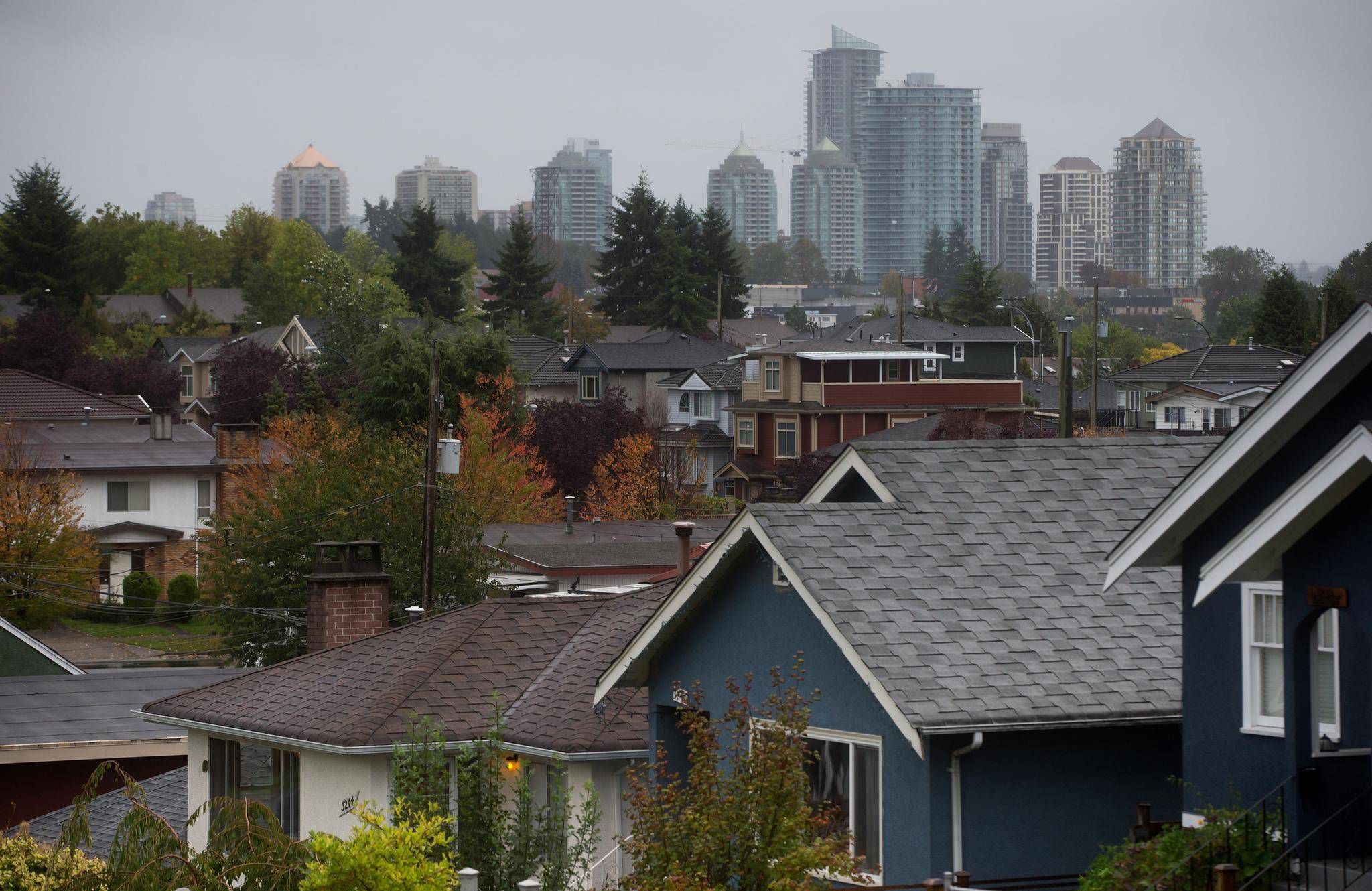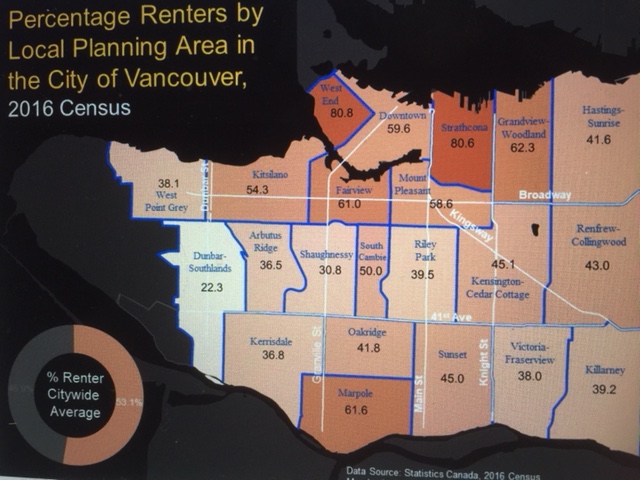
The Duke of Data Andy Yan, Director of the City Program at Simon Fraser University has been reviewing the 2016 census data looking at who is renting accommodations in Vancouver. Andy Yan found some surprises that challenge the stereotype of what has been termed as “large single family home” neighbourhoods. Originally expecting that maybe 10 per cent of units were rental in these areas, Andy found that “West Point Grey with its big, expensive detached houses, is 38 per cent renter households. Kerrisdale is 36.8 per cent renters. Shaughnessy, with its stock of old and new mansions, is made up of 30 per cent renters.”
The Globe and Mail’s Kerry Gold observes that Andy Yan has found that “24 per cent of all renter households are living in the so-called “single family home” areas that provide an invisible affordability often ignored by development pundits.That means that in terms of planning, we should be sensitive to how people are actually using housing types. Zoning changes can be the ruin of an established community. It’s not enough to rezone without examining how that housing is being used, and by whom – not if the goal is to create affordable housing while keeping people within the community.”
While 53 per cent of Vancouverites rent their homes, the findings challenge what has been viewed as “single family” homes. The term “single family dwelling unit” is a hangover from the 1950’s zoning terminology and should perhaps be changed to reflect its form, not so much its function. Families today are rarely “nuclear” (another hangover from the atomic age) but may house multiple families or unrelated people.
Andy Yan’s takeaway is that the so called “single family” zoning does not adequately project who is living there, and the importance of exploring data. While purpose-built rental housing is necessary ““We need to get over our zoning and form fetishes and go back to creating communities for people. You just can’t spray density around and pray that affordability will follow. ” The CEO of Landlord BC David Hutniak observes that secondary rental suites in large houses make up to 54 per cent of the rental market. He notes that Vancouver has a “very incestuous development community” that can make good returns preselling and flipping condo developments and has had no reason to build rental housing. “After 40 years of no purpose built rental construction, and a lot of condos, there is a prevalence of the secondary market for rental housing. Thank God we have it, but in terms of security of tenure it’s never been to the same degree as purpose-built rentals.”
There is also a fulsome discussion from writer Melody Ma who has written a compelling article on the importance of the Vancouver Special housing form and the opportunity these large freestanding houses had to shelter multi-generational and extended families. Ms. Ma notes that these “are densely populated homes that encourages multiple generations to support each other within close quarters. It is an affordable way of living and arguably even a model way of living for the future”. Her article is well worth reading.

Source: Andy Yan













So 80% of the land holds 24% of renters? It may be higher than would be assumed, but it doesn’t seem especially high to me?
Presumably a significant proportion of those renting in “Single Family” areas are in ADUs (Basements, Laneway houses)? How does this provide the security of tenure that the CEO of Landlords BC quite rightly thinks is important?
… especially if technically, many of those ADUs are illegal … like the houses in Kits which are now multiple apartments, but which are not grandfathered anywhere, and so, are simply one required building permit away from being required to be ‘desuited’.
Why is the presence of suites in houses news? Twenty years ago when illegal suites were legalized it was estimated that over 50% of detached housing in Vancouver contained them. This is supposedly a new discovery? Any UBC student from the 70s through today could have provided inside information on renting in the west side.
Kerry Gold’s articles are permeated with an anti-development narrative, and she has defended not just the status quo in zoning, but actually moving backwards and downzoning to preserve even very large west side lots. Saving character homes in character neighbourhoods and rallying against foreign wealth are her constant themes in that regard.
Andy Yan’s figures and Gold’s predictable narrative still ignore a most important fact: we are out of land. Land in its current form (80% RS 1) is to be pickled and put in a museum, is it? Heritage and “character” homes do not require a 4,000 ft2 lot to maintain their status. That smacks of west side arrogance that disregards east side heritage and character that happens to be ingeniously placed on small lots, or on standard lots with more units. Where does it say neighbourhood character will die if the overly generous 24-foot front yard setbacks and overall lot coverage were used more efficiently?
There are streets and neighbourhoods in Mount Pleasant, Grandview Woodlands, Riley Park and parts of Coquitlam and New Westminster that are overflowing with heritage architecture and collective charm and character that are dominated by half lots, 10-foot setbacks and more than 50% lot coverage. Arguably with a higher population living within “missing middle” and “smart growth” urban design principles comes a greater demand for local services and shops and walkable local commercial streets. In other words, holistic communities rather than a heritage precedent for the sprawling suburbs.
And guess what? The majority of these older higher density neighbourhoods predate the zoning bylaws by up to 50 years. That is, they evolved naturally as espoused by David Hutniak based on family needs first. In my neighbourhood there are occasional two-storey apartment buildings with seven or eight rental suites built on one standard 33-foot lot that punctuate the detached home vernacular. They are brimming over with Edwardian character and affordability, yet with the above narrative would violate some ill-defined principle on open space by having a lot coverage hovering around 85%.
What these critics seem to lack is a sense that they understand site planning and urban design principles and urban economics. Subdividing standard lots into smaller increments and promoting land planning efficacy does not preclude saving heritage and affordable rentals unless we let it. Infilling a large lot does not automatically demolish the original structure with affordable rentals unless we let it. So stop letting it already! Bring forward the many-faceted creativity of site planning and architecture contained in the concept of the missing middle where land use planning can realize its full potential, and where heritage and affordable rentals are not sacrificed.
There are century-old heritage land planning precedents. Just not on the west side, which seems to be the sole obsession of too many critics here at the expense of the rest of the city and Metro.
Melanie Ma’s piece rings true. But I remember every heritage tour of Strathcona (where I also lived for two years) where an older Edwardian Special predominated many decades before the traditional Vancouver Special. Some have been bought and renovated in ingenious ways, one in particular where two 25-foot lots were combined into a shared back yard, and where several more units were built than originally, including basement and above-garage granny flats. There are no doubt generations of families living there.
There was a Vancouver Special competition years back where the standard lot contained a bigger house in front with a smaller house in back, both attached together with a galleria and courtyard, thus allowing several generations of a family to live together and balance privacy with common space. The courtyard was a key practical feature, like an outdoor rec room or living room. There were 11 Specials built under the special zoning created for them that allowed greater than 30% lot coverage, but in some cases builders immediately maxed every dimension possible in pumped-up designs using and cheap materials and a dog’s breakfast of faux architectural styles rendered in stucco. The city reacted by shutting down the program, which should really have been tweaked instead. Ma is likely relating to the original Specials of the 60s and 70s that were simple, compact and well-built with durable materials, and unadorned. That model could be used to foster another generation of Specials, but with simple, durable row houses containing rental suites.
This is to say that another group of critics need to pipe up and demonstrate with illustrations and real projects that shifting the standard and large lot paradigm into the 21st Century will not harm our cities, but will in fact make them more livable and affordable primarily by dividing expensive land into smaller units, by dramatically increasing rental stock, by protecting heritage, and by increasing family wealth through rental suite income. Non-market solutions need to also be part of the solution.
deleted as per editorial policy.Please read policy
No, I don’t enjoy countering flawed published narratives and misconceptions. I do find it good exercise, though, in the sense of pushing a rock up a hill. To be honest, I have better things to do.
The main post was about rentals in “single family” housing. But if you need to have one single opinion on foreign money in real estate your are entitled to it. Just don’t call it a “fact” until all the data is collected and we all can see the level of actual foreign influence vs. conjecture vs. every other influence. I’m not arriving at any conclusions until then, despite the ongoing chronicles with implied and predetermined conclusions.
The data isn’t looking directly at renters in single family homes, or renters of whole houses vs those renting suites. It doesn’t exclude the apartments that exist in all those places. So all it found was that lower density neighbourhoods had a lower percentage of renters, though the rate is non zero.
So while it’s true there are lots of renters in neighbourhoods people traditionally think of as single family, it doesn’t change the fact that houses and especially suites in houses are the least secure and generally least desirable form of rental housing.
Since Vancouver is built out, you generally have to tear down *something* to build new housing. The type of housing that impacts the poor and renters the least when you tear it down is single family houses.
Living in a single family house isn’t bad, and people who do or want to aren’t bad. Requiring we allocate most of the city to that use is bad. It comes at the expense of the young, the newly arrived, of renters and the poor
+1! 🙂
“It doesn’t exclude the apartments that exist in all those places” I wondered about that. Kerrisdale was flagged up as having a high renter percentage, but that area contains a lot of apartment buildings in the blocks close to 41st & Arbutus (Purpose-built and condos being rented out by their owners).
Author
Reblogged this on Sandy James Planner.